AZ-104: Microsoft Azure Administrator
You have an Azure subscription named Subscription1.
You have 5 TB of data that you need to transfer to Subscription1.
You plan to use an Azure Import/Export job.
What can you use as the destination of the imported data?
a virtual machine
an Azure Cosmos DB database
Azure File Storage
the Azure File Sync Storage Sync Service
Answer is Azure File Storage
Azure Import/Export service is used to securely import large amounts of data to Azure Blob storage and Azure Files by shipping disk drives to an Azure datacenter.
The maximum size of an Azure Files Resource of a file share is 5 TB.
Note: There are several versions of this question in the exam. The question has two correct answers:
1. Azure File Storage
2. Azure Blob Storage
The question can have other incorrect answer options, including the following:
- Azure Data Lake Store
- Azure SQL Database
- Azure Data Factory
Reference:
https://docs.microsoft.com/en-us/azure/storage/common/storage-import-export-service
You have an Azure subscription.
You create the Azure Storage account shown in the following exhibit.
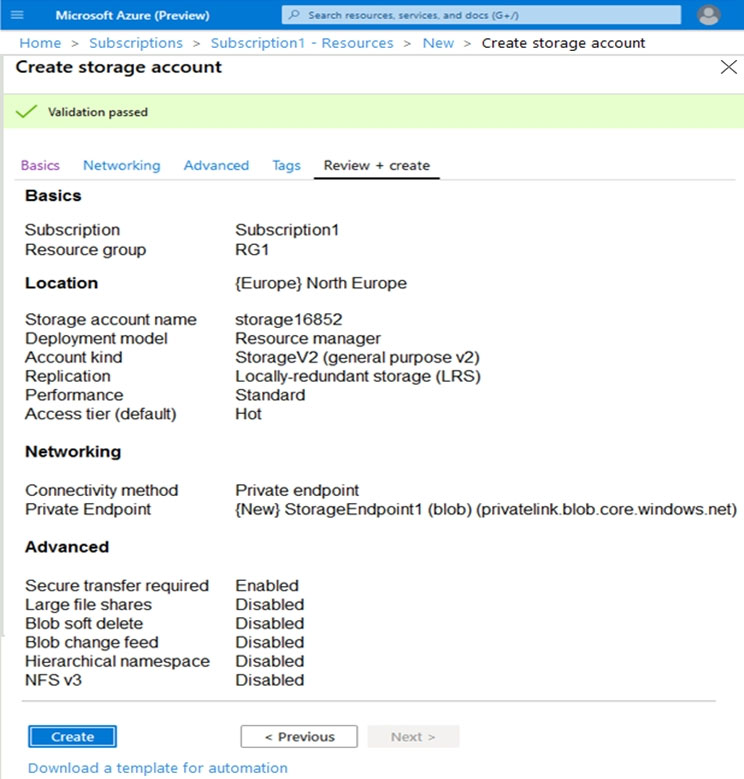
Use the drop-down menus to select the answer choice that completes each statement based on the information presented in the graphic.
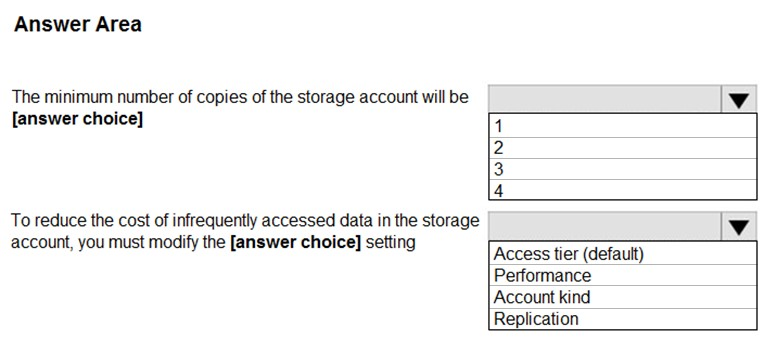
Box 1: 3
Locally Redundant Storage (LRS) provides highly durable and available storage within a single location (sub region). We maintain an equivalent of 3 copies (replicas) of your data within the primary location as described in our SOSP paper; this ensures that we can recover from common failures (disk, node, rack) without impacting your storage account's availability and durability.
Box 2: Access tier
Change the access tier from Hot to Cool.
Note: Azure storage offers different access tiers, which allow you to store blob object data in the most cost-effective manner. The available access tiers include:
Hot - Optimized for storing data that is accessed frequently.
Cool - Optimized for storing data that is infrequently accessed and stored for at least 30 days.
Archive - Optimized for storing data that is rarely accessed and stored for at least 180 days with flexible latency requirements (on the order of hours).
Reference:
https://azure.microsoft.com/en-us/blog/data-series-introducing-locally-redundant-storage-for-windows-azure-storage/
https://docs.microsoft.com/en-us/azure/storage/blobs/storage-blob-storage-tiers
You have an Azure Storage account named storage1.
You plan to use AzCopy to copy data to storage1.
You need to identify the storage services in storage1 to which you can copy the data.
What should you identify?
blob, file, table, and queue
blob and file only
file and table only
file only
blob, table, and queue only
Answer is blob and file only
AzCopy is a command-line utility that you can use to copy blobs or files to or from a storage account.
Incorrect Answers:
A, C, E: AzCopy does not support table and queue storage services.
D: AzCopy supports file storage services, as well as blob storage services.
Reference:
https://docs.microsoft.com/en-us/azure/storage/common/storage-use-azcopy-v10
You have an Azure subscription that contains an Azure Storage account.
You plan to create an Azure container instance named container1 that will use a Docker image named Image1. Image1 contains a Microsoft SQL Server instance that requires persistent storage.
You need to configure a storage service for Container1.
What should you use?
Azure Files
Azure Blob storage
Azure Queue storage
Azure Table storage
Answer is Azure Files
In Azure container instances, you can mount Azure File shares for persistent storage. Azure files are used as persistent disks for docker images. It doesn't matter the type of the image or its functionality.
Persistent shared storage for containers. Easily share data between containers using NFS or SMB file shares. Azure Files is tightly integrated with Azure Kubernetes Service (AKS) for easily storing and managing data.
Reference:
https://azure.microsoft.com/en-us/blog/persistent-docker-volumes-with-azure-file-storage
https://azure.microsoft.com/en-us/services/storage/files/#features
You have an Azure subscription named Subscription1.
You have 5 TB of data that you need to transfer to Subscription1.
You plan to use an Azure Import/Export job.
What can you use as the destination of the imported data?
an Azure Cosmos DB database
Azure Blob storage
Azure Data Lake Store
the Azure File Sync Storage Sync Service
Answer is Azure Blob storage
Azure Import/Export service is used to securely import large amounts of data to Azure Blob storage and Azure Files by shipping disk drives to an Azure datacenter.
Note:
There are several versions of this question in the exam. The question has two correct answers:
1. Azure File Storage
2. Azure Blob Storage
The question can have other incorrect answer options, including the following:
- a virtual machine
- Azure SQL Database
- Azure Data Factory
Reference:
https://docs.microsoft.com/en-us/azure/storage/common/storage-import-export-service
You have an Azure subscription that contains an Azure file share.
You have an on-premises server named Server1 that runs Windows Server 2016.
You plan to set up Azure File Sync between Server1 and the Azure file share.
You need to prepare the subscription for the planned Azure File Sync.
Which two actions should you perform in the Azure subscription?
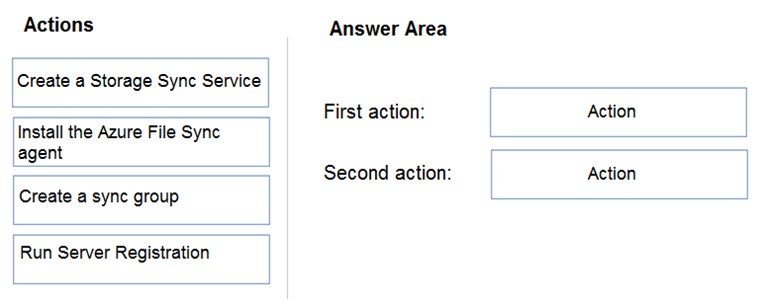
1. Create a Storage Sync Service.
2. Create a sync group.
3. Install Azure File Sync agent on the server with the full data set.
4. Register that server and create a server endpoint on the share.
Reference:
https://docs.microsoft.com/en-us/azure/storage/file-sync/file-sync-deployment-guide?tabs=azure-portal%2Cproactive-portal
You have an Azure subscription that contains the storage accounts shown in the following exhibit.

Use the drop-down menus to select the answer choice that completes each statement based on the information presented in the graphic.
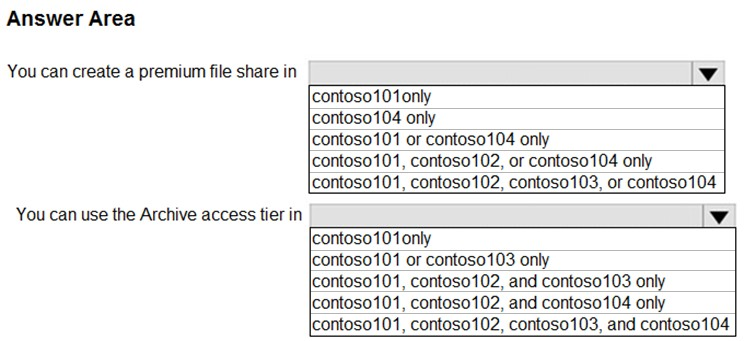
Box 1: contoso104 only
Premium file shares are hosted in a special purpose storage account kind, called a FileStorage account.
Box 2: contoso101 or contos103 only
Object storage data tiering between hot, cool, and archive is supported in Blob Storage and General Purpose v2 (GPv2) accounts. General Purpose v1 (GPv1) accounts don't support tiering.
The archive tier supports only LRS, GRS, and RA-GRS.
Reference:
https://docs.microsoft.com/en-us/azure/storage/common/storage-account-overview
https://docs.microsoft.com/en-us/azure/storage/files/storage-how-to-create-premium-fileshare?tabs=azure-portal
https://docs.microsoft.com/en-us/azure/storage/blobs/storage-blob-storage-tiers
You have an Azure subscription named Subscription1.
In Subscription1, you create an Azure file share named share1.
You create a shared access signature (SAS) named SAS1 as shown in the following exhibit:
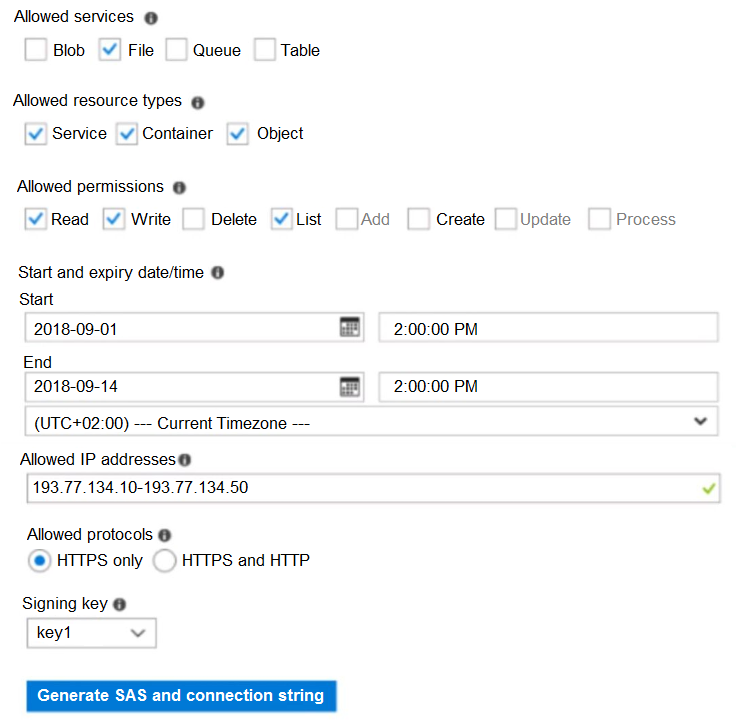
To answer, select the appropriate options in the answer area.
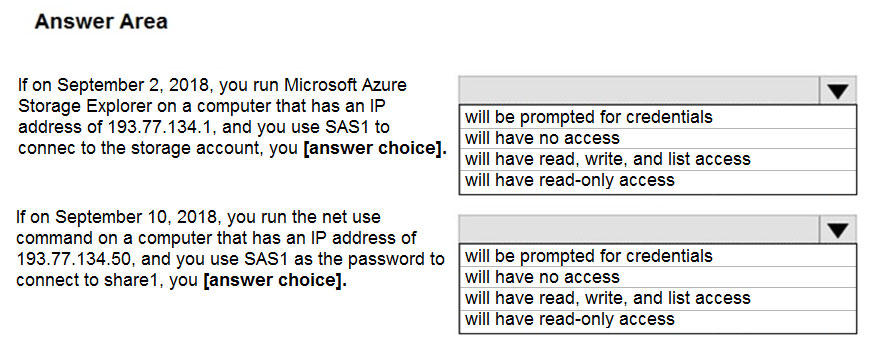
Box 1: will have no access
The IP 193.77.134.1 does not have access on the SAS, because it is not matching the SAS requirements. IP is out of range.
Box 2: will have no access
The SAS token is not supported in mounting Azure File share currently, it just supports the Azure storage account key.
Since it is using "net use" where it uses SMB, the SMB (Server Message Broker) protocol does not support SAS. it still asks for username/password. Accordingly, it will give error wrong username/pass and will not provide access.
Reference:
https://docs.microsoft.com/en-us/azure/storage/common/storage-dotnet-shared-access-signature-part-1
https://docs.microsoft.com/en-us/azure/vs-azure-tools-storage-manage-with-storage-explorer?tabs=windows
https://docs.microsoft.com/en-us/azure/storage/files/storage-how-to-use-files-windows
https://docs.microsoft.com/en-us/answers/questions/40741/sas-key-for-unc-path.html
You have a general-purpose v1 Azure Storage account named storage1 that uses locally-redundant storage (LRS).
You need to ensure that the data in the storage account is protected if a zone fails. The solution must minimize costs and administrative effort.
What should you do first?
Create a new storage account.
Configure object replication rules.
Upgrade the account to general-purpose v2.
Modify the Replication setting of storage1.
Answer is Upgrade the account to general-purpose v2.
v1 supports GRS/RA-GRS but question was about least cost. Least cost is ZRS which is only supported for v2 and premium file/block storage.
Reference:
https://docs.microsoft.com/en-us/azure/storage/common/storage-redundancy#supported-storage-account-types
You have an Azure subscription that contains the storage accounts shown in the following table.

You plan to manage the data stored in the accounts by using lifecycle management rules.
To which storage accounts can you apply lifecycle management rules?
storage1 only
storage1 and storage2 only
storage3 and storage4 only
storage1, storage2, and storage3 only
storage1, storage2, storage3, and storage4
Answer is storage1, storage2, and storage3 only
The lifecycle management feature is available in all Azure regions for general purpose v2 (GPv2) accounts, blob storage accounts, premium block blobs storage accounts, and Azure Data Lake Storage Gen2 accounts